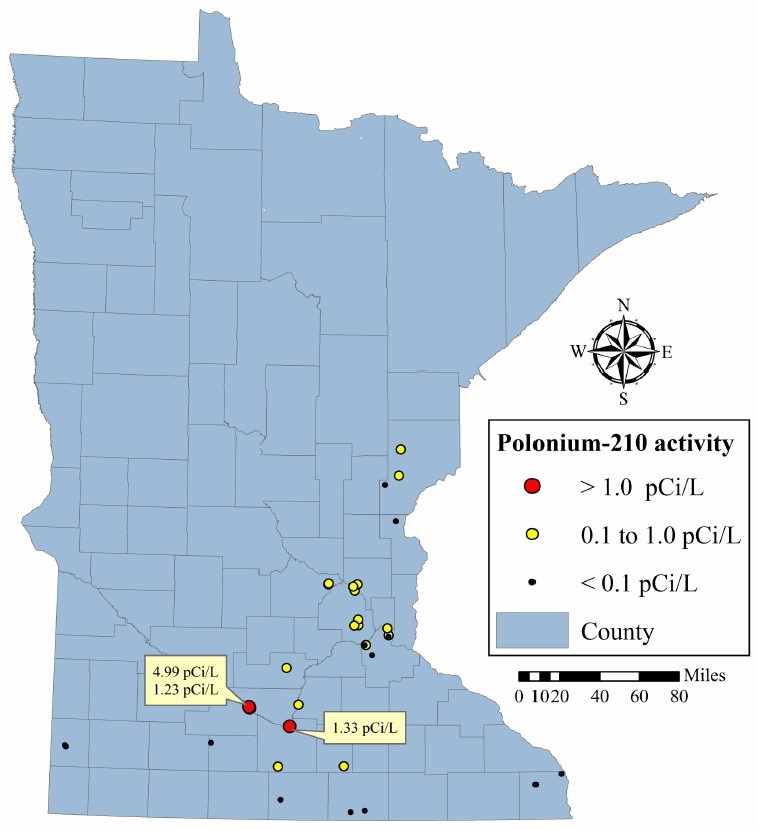Clean Water Fund: Contaminants of Emerging Concern (CEC)
MDH Legacy Initiatives
- Clean Water Fund Home
- Contaminants of
Emerging Concern - Groundwater Protection Initiative - Accelerated Implementation Grant
- Groundwater Restoration and Protection Strategies (GRAPS)
- Pathogen Project
- Private Well Protection
- Source Water Protection Planning and Grants
- Water Reuse
Related Topics
Environmental Health Division
Radionuclide Special Project
Project background
Radioactive elements, also called radionuclides, occur naturally in the environment, including in groundwater aquifers. Aquifers are underground layers of sand, rock, and water. Seventy percent of Minnesotans rely on groundwater aquifers for their drinking water. Radionuclides are commonly detected at low levels in some groundwater sources, and federal standards exist to limit exposure to people drinking water from community water supplies.
Radionuclides are unstable, and break down (decay) into different elements. This change occurs over time, releasing energy called ionizing radiation. This radiation is released in the form of rays or high speed particles called alpha particles, beta particles, and gamma rays. Ionizing radiation in any form can be harmful to human health.
Staff at the Minnesota Department of Health (MDH) recently looked at specific radionuclides in groundwater for which we have little or no occurrence information for Minnesota. Polonium-210 is one radionuclide of interest because we don’t know much about its occurrence and it emits alpha particles, a very concentrated form of radiation. Lead-210 is another radionuclide of interest because it has also been found in groundwater and decays into polonium-210. The U.S. Environmental Protection Agency (EPA) highlighted polonium-210 and lead-210 as possible contaminants of concern for groundwater sources in 1999, but it was too difficult to measure until recently. We have started the study because polonium-210 can now be detected at very low levels.
Project details
The CEC Radionuclide Project has three goals:
- Understand the occurrence of specific, understudied radionuclides in groundwater
- Determine the potential for human exposure to radionuclides after drinking water treatment
- Examine the magnitude of any possible health risks
The first phase of this assessment involved sampling 32 groundwater wells in 11 aquifers to determine whether or not polonium-210 was in the groundwater at all. The small number of wells were selected for the sampling based on prior detections of radionuclides, and were generally clustered in the southern half of the state.
Polonium-210 was found in most untreated groundwater samples and three samples following water treatment. The earliest round of sample collection shows very low levels of polonium-210 activity in deep groundwater aquifers. A few samples in the south-central portion of the state contained higher levels of polonium-210 activity. Lead-210 was also determined in ten samples. MDH would like to follow up this initial sampling effort by further examining a selection of untreated groundwater wells which had higher levels of polonium-210. Because polonium-210 requires an outside contractor to do the analysis, careful planning is underway to design the best possible follow-up study.
MDH currently applies the EPA drinking water standard for naturally occurring radionuclides, which includes the type of radiation released by polonium-210. However, the health risks of polonium-210 alone have not been assessed, and no specific polonium-210 drinking water standard exists.
Project applications
This project is telling us where polonium-210 is occurring in Minnesota. The small number of samples involved does not give a statewide occurrence estimate, but it does tell us that polonium-210 is present in certain groundwater sources that are already known to contain natural radioactivity. Although the results will not be used for drinking water quality standards, the project may cause MDH to more closely examine this issue.
Preliminary results from the pilot study suggest that one aquifer in particular, the Mt. Simon aquifer, contains higher levels of polonium-210 in untreated water in a few locations compared to other aquifers. To properly understand any potential health risks, we would also need to study the effect of drinking water treatment in place at these locations and take multiple polonium-210 samples over the course of a year. As more data are gathered on specific radionuclides such as polonium-210 and lead-210, MDH can better understand the cumulative health risks from radioactivity in drinking water.
Sharing the science
The presence of polonium-210 and lead-210 in drinking water has not been studied extensively by scientists. MDH’s research in this area may lead to further consideration of potential health risks from understudied radionuclides. Therefore, MDH scientists are sharing their findings at professional society meetings. For more information, see:
Polonium-210 Occurrence in Minnesota’s Aquifer’s: A Pilot Study (PDF)
Poster presentation on the radionuclide assessment project
MDH also maintains a full technical report of the Polonium-210 Pilot Study and can share this report upon request. Please email health.risk@state.mn.us or call 651-201-4899.

